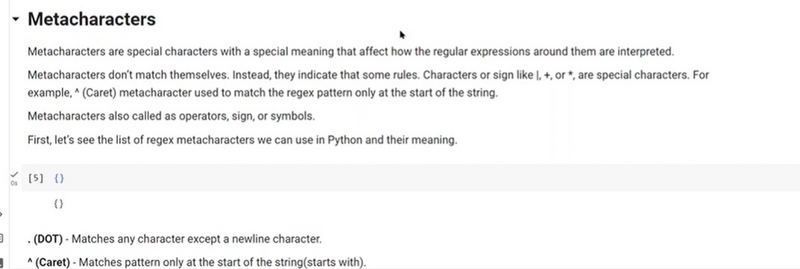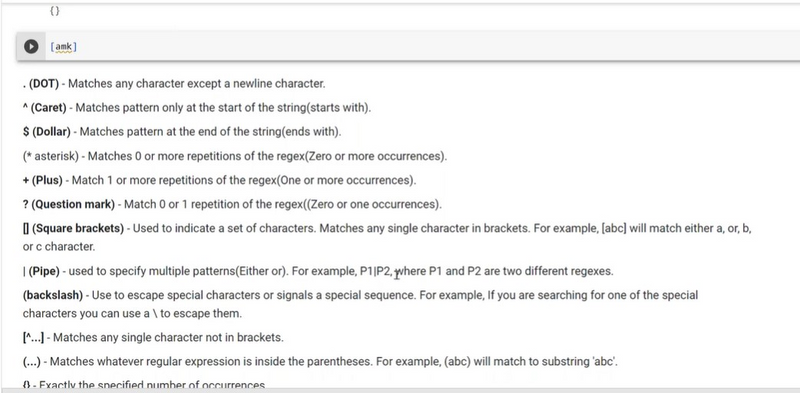In machine learning and text processing, regular expressions (regex) are used to define patterns for matching and extracting specific pieces of text from larger datasets. Regular expressions are composed of various metacharacters and symbols that have special meanings. Here's a list of some commonly used regex metacharacters along with examples:
Metachar
dot,*,+,?,(),{},$,^,\,\b,\d,\w,\s
. (Dot):
Matches any character except a newline.
Example: a.b matches "axb", "a2b", "a@b", etc.
(Asterisk):
Matches zero or more occurrences of the preceding character or group.
Example: ca*t matches "ct", "cat", "caaat", etc.
+ (Plus):
Matches one or more occurrences of the preceding character or group.
Example: ca+t matches "cat", "caaat", but not "ct".
? (Question Mark):
Matches zero or one occurrence of the preceding character or group.
Example: colou?r matches "color" and "colour".
| (Vertical Bar):
Acts as an OR operator, allowing you to specify alternatives.
Example: cat|dog matches either "cat" or "dog".
Defines a character class; matches any one of the characters within the brackets.
Example: [aeiou] matches any vowel.
[^] (Caret Inside Square Brackets):
Defines a negated character class; matches any character that is not in the brackets.
Example: [^0-9] matches any non-digit character.
() (Parentheses):
Groups characters together, creating a subexpression.
Example: (abc)+ matches "abc", "abcabc", etc.
{} (Curly Braces):
Specifies a specific number of occurrences.
Example: a{3} matches "aaa".
\ (Backslash):
Escapes a metacharacter, allowing you to match it as a literal character.
Example: \$ matches a dollar sign "$".
^ (Caret):
Matches the start of a line (or string).
Example: ^Start matches "Start of text".
$ (Dollar Sign):
Matches the end of a line (or string).
Example: end$ matches "end of text".
\b (Word Boundary):
Matches a word boundary, typically used for whole-word matching.
Example: \bword\b matches "word" but not "wording".
\d (Digit):
Matches any digit (equivalent to [0-9]).
Example: \d{2} matches any two-digit number.
\w (Word Character):
Matches any word character (equivalent to [a-zA-Z0-9_]).
Example: \w+ matches one or more word characters.
\s (Whitespace):
Matches any whitespace character (e.g., space, tab, newline).
Example: a\sb matches "a b".
(?i) (Case-Insensitive Flag):
Makes the regex pattern case-insensitive.
Example: (?i)abc matches "abc", "ABC", "AbC", etc.
(?s) (Single-Line Mode Flag):
Allows . to match newline characters.
Example: a.b matches "a\nb" when using (?s).
These are some of the fundamental regex metacharacters and techniques commonly used in machine learning and text processing tasks. They allow you to define complex patterns for data extraction, validation, and manipulation. Depending on your specific requirements, you may need to combine multiple metacharacters and regular expressions to achieve the desired results.



Top comments (0)